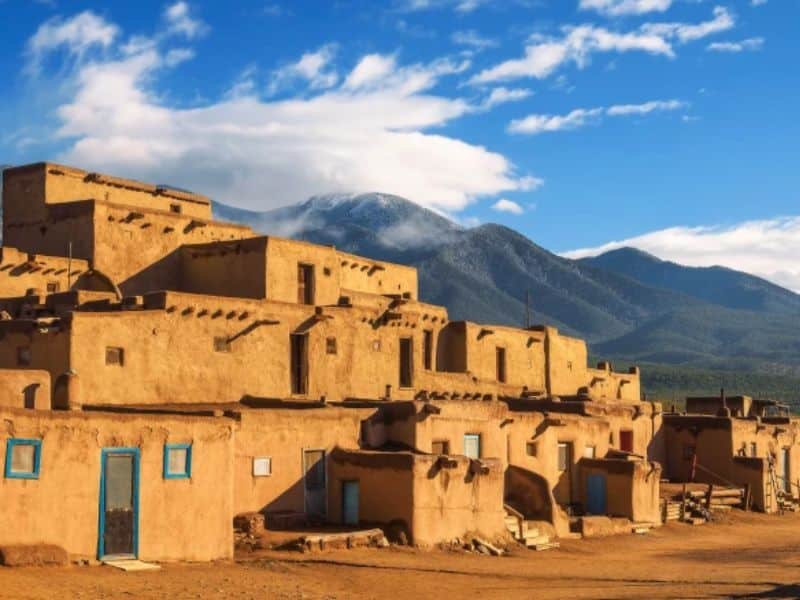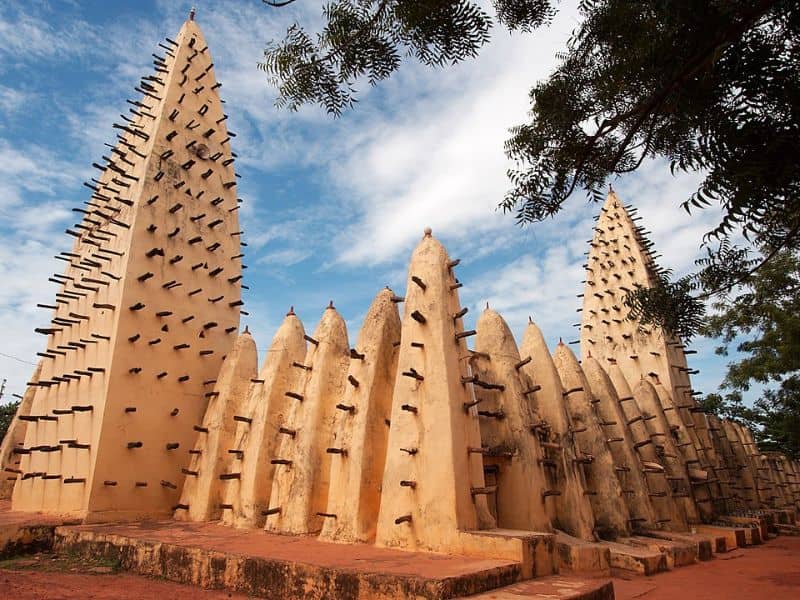Famous Adobe Buildings Around the World – Top 6 Examples

Images courtesy of Ghoghnos Inc, AFAR Media, New Mexico Tourism Department, and New Mexico Tourism Department.
Adobe has been the go-to material for centuries when high-tech solutions were not around. From the Americas to Africa, countless cultures have used adobe to construct some of the most iconic structures we know today.
From landmark churches to vibrant housing colonies, adobe’s use can be seen in the construction of many ancient cities across the globe.
Some of the most famous adobe buildings include The Great Mosque of Djenne, the largest adobe structure in the world. Taos Pueblo in New Mexico and the San Miguel Mission in Spain are other examples of adobe structures with historical significance.
I will briefly discuss the six most famous adobe buildings representing architecture’s incredible diversity and beauty worldwide.
With their rich history and construction, they are definitely worth exploring. So, stay till the end to know what makes these structures unique and how they have played a huge role in their respective cultures.
Examples of Iconic Adobe Buildings Around the World
1. The Great Mosque of Djenné

History and Significance
The Great Mosque of Djenné has a rich history and was built in the 13th century. King Koi Konboro decided to build this Mosque during his reign.
Since its inception, it has undergone several reconstructions, with the most recent one done in 1907.
Architectural Features
The Mosque is primarily built from banco, a mixture of clay and rice husks, and this mix offers excellent insulation against the region’s heat and is readily available.
One of the multiple amazing features of the Mosque is the three imposing towers, which are located in the qibla (a prayer hall).
There are cone-shaped pinnacles at the top of each tower, decorated with ostrich eggs. These buildings are adorned with wooden beams called torons that jut out from the walls, and the torons serve as scaffolding during maintenance.
The Mosque also boasts a large courtyard and a prayer hall.
Cultural and Historical Context
The Great Mosque of Djenné stands as a testament to the presence of Islam in Western Africa.
Today, the Djenné community participates in an annual gathering focusing on the Mosque’s maintenance. The community repairs the damage on the adobe structure inflicted in the past year due to weather conditions.
2. Arg-é Bam, Iran

History and Significance
Arg-é Bam’s exact origin date is unknown. However, it is believed to be constructed during the Achaemenid period (579-323 BC).
Arg-é Bam was likely used as a citadel for defense, mainly due to its strategic hilltop overlooking the desert. It was also an administrative center for trade along the Silk Road.
Architectural Features
Arg-é Bam complex has two main parts: a fortress and an inner city. The walls of this fortress are made up of sun-dried mud bricks called khesht.
These bricks are held together with layers of mud mortar (chineh). The inner city contains several important buildings like mosques, Baths, Caravanserais, and other residential areas.
Even though massive destruction occurred following the 2003 earthquake, the government has rebuilt the Arg-é Bam brick by brick like before.
Cultural and Historical Context
Arg-é Bam has significantly impacted Iranian culture throughout history and actively reflects the traditional Persian building techniques passed down through generations.
It also served as a strategic administrative center for trade along the Silk Road that connected Europe with Asia. Today, Arg-é Bam is a reminder of Iran’s rich cultural heritage and still continues to be a popular tourist attraction.
3. Taos Pueblo

History and Significance
Taos Pueblo has its origins dating back to more than 1000 years ago. This structure, also a UNESCO World Heritage Site, was built by the native Tiwa-speaking Puebloan people.
Taos Pueblo has played an important role in upholding the region’s indigenous culture, with the community continuing to practice customs, traditions, and rituals to this day.
Architectural Features
Taos Pueblo’s architecture is characterized by its multi-storied adobe buildings. The Taos Pueblo as a whole consists of two main structures:
- Hlauuma (North house)
- Hlaukwima (South house)
These structures can reach up to five stories in height and have interconnected rooms that can be accessed through ladders and rooftop openings.
Traditional Puebloan techniques were used in the building of Taos Pueblo. This involved shaping adobe bricks from a mix of locally sourced materials.
Cultural and Historical Context
Taos Pueblo holds immense cultural significance both locally and globally. It has inspired generations of artists, writers, and photographers that have been mesmerized by the rich cultural heritage of its inhabitants.
Additionally, it serves as a living example of the resilience, strength, and adaptability of the native Puebloan people.
4. The Poeh Center, New Mexico, USA

History and Significance
The Poeh Center is another solid example of an adobe structure with huge cultural importance. Built in 1988 by Pojoaque Pueblo, it serves as a center of the arts and culture of the Pueblo people.
The center emphasizes cultural preservation and revitalization through art, music, dance, and storytelling. It has become a hub for showcasing traditional and contemporary Native American art from well-respected artists.
Architectural Features
The Poeh Center is a huge piece of adobe structure built with an eye toward its past and future. The architecture reflects the traditional adobe style while incorporating modern elements to make it unique.
Its earth tones, wooden beams, and stone accents combine to create a warm ambiance that invites visitors to explore its many offerings.
Cultural and Historical Context
The Poeh Center stands as a testament to the resilience of the Native American culture in the face of adversity.
The center was created at a time when Native Americans were struggling for recognition and rights in mainstream society. But it still became a beacon for preserving the Native traditions and celebrating their heritage.
The authorities of the Poeh Museum give Native American artists free studio space to display their art.
Overall, the Poeh Center serves as a reminder that our history does not exist in isolation but is rather intertwined with other cultures.
Its presence in Santa Fe has helped foster understanding between different communities while also providing an opportunity for visitors to experience why this area is so special.
5. San Miguel Mission

History and Significance
Spanish Franciscan missionaries built The San Miguel Mission in the early 17th century, around 1610. The main aim of building the Mission was to spread Christianity among the native Pueblo people.
The Mission’s structure was built on top of a Kiva, which is a ceremonial structure used by the Pueblo people for religious purposes.
Over the years, the structure has seen several reconstructions due to natural disasters or conflicts, with the current reconstructed structure dating back to 1710.
Architectural Features
The San Miguel displays a modest yet elegant example of Spanish colonial architecture. Its adobe walls, wooden ceiling beams (vigas), and bell tower characterize this.
The church’s interior features a wooden altar screen (reredos) adorned with paintings of saints and other religious figures.
The Mission’s design reflects the blending of Spanish and indigenous Pueblo influences, which was quite common during the early colonial period in New Mexico.
The Mission also houses a historical bell known as the San Jose Bell, which dates back to 1856 and is believed to have been brought from Spain.
Cultural and Historical Context
The San Miguel Mission holds immense cultural significance within the broader context of the Southwestern US.
As one of the oldest Parish churches in the country, it serves as a testament to the early Spanish colonial presence in the region and the interactions between the Spanish missionaries and the native Pueblo people.
The Mission’s architecture and design also provide valuable insights into the various blends of cultures that took place during this period.
Today, the Mission is still an active parish church plus a popular tourist destination that attracts worldwide visitors interested in its rich history.
The Mission’s enduring presence serves as a reminder of the region’s complex cultural history and the lasting Spanish colonialism on the landscape and identity of the Southwestern United States.
6. The Grand Mosque of Bobo-Dioulasso

History and Significance
The Grand Mosque of Bobo-Dioulasso is one of the oldest and most prominent mosques in Burkina Faso.
Built in the late 19th century, the Mosque served as a center for Islamic worship and religious education, playing an important role in the spiritual lives of the local Muslim community.
The Mosque’s establishment and enduring presence highlight the importance of the Islamic religion and its influence on the cultural fabric of West Africa.
West Africa has long been a melting pot of various ethnic groups, including the Bobo, Mossi, and Mandinka groups.
Each group has its distinct customs and traditions, and the Mosque is a testament to these diverse communities’ harmonious coexistence and shared reverence for the Islamic faith and heritage.
Architectural Features
The Grand Mosque showcases the Sudano-Sahelian architectural style, characterized by its use of adobe brick construction and wooden support beams.
The Mosque’s design features interconnected rooms, courtyards, and corridors, with a central prayer hall accommodating a large congregation.
The two large minarets are among its most distinct features. These are adorned with wooden beams or torons. These torons serve a structural and decorative function, supporting the walls while adding visual interest.
Cultural and Historical Context
The Grand Mosque is situated within a cultural landscape with other notable landmarks. These include the historic Old Quarter of Bobo-Dioulasso, the sacred Konsa house, and the lively central market.
The Mosque has also witnessed significant events in the region’s history, including periods of colonial rule, national independence, and political upheavals.
Final Takeaways
To summarize, the architectural significance of these six adobe structures lies partly in their use of adobe as a building material.
This material has not only endured the test of time but has also been witness to a cultural transformation over the years.
Each building showcases unique features that reflect different cultures. Sustainable construction continues to inspire architects, artists, and historians alike. Therefore, these structures must be preserved for future generations and to promote sustainable architecture in today’s world.







